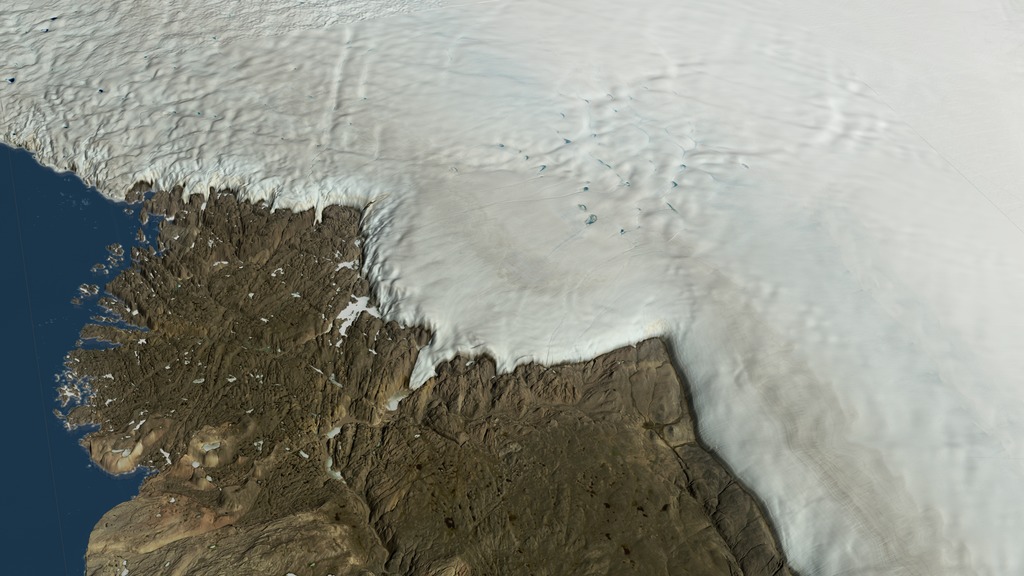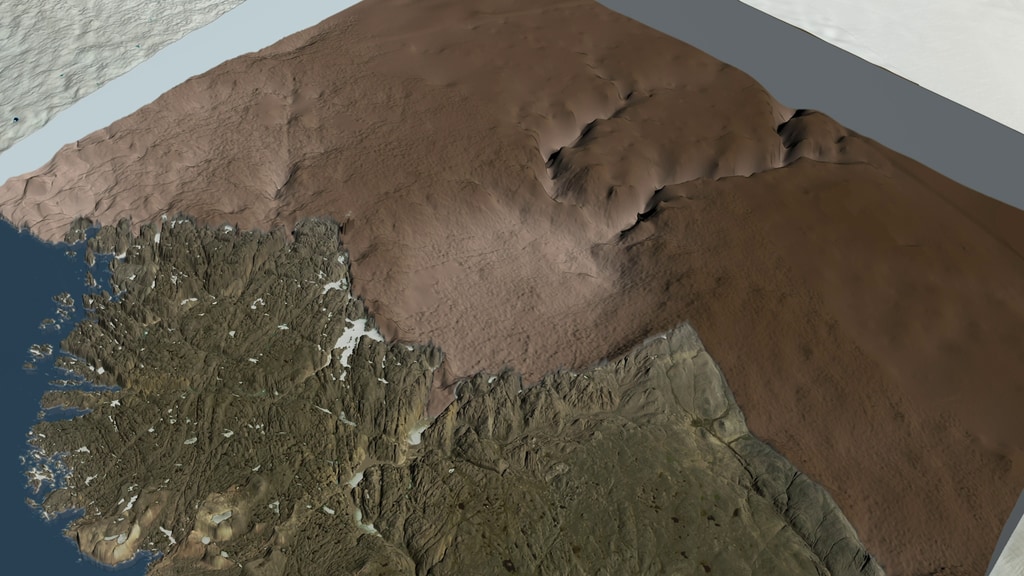Greenland's Hiawatha Crater
This visualization shows the location of the Hiawatha Glacier near Inglefield Land in northwest Greenland. The surface of the ice sheet fades away to show the impact crater discovered beneath the ice sheet. A red cylinder shows the best-fit rim of the impact crater and a measuring stick shows that the diameter of the crater is more than 31 kilometers across. The size of the crater is compared to the cities of Washington, DC and Paris, France.
The visualization also shows how the scientists from Germany's Alfred Wegener Institute (AWI) flew the Polar 6 aircraft (a DC-3T) to collect radar data over the Hiawatha impact crater. The radar data is shown in detail as curtains of the radar data are dissolved away to display the layers of the ice sheet in the interior of the crater.
The Hiawatha impact crater was first suspected to exist in the summer of 2015, from examination of a compilation of Greenland's sub-ice topography radar measurements made by NASA over two decades. Subsequently, a team of scientist at Germany's Alfred Wegener Institute flew an airborne survey over the region in the spring 2016, using a new ultrawideband radar sounder developed by the Center for Remote Sensing of Ice Sheets at The University of Kansas.
Ice-penetrating radar sends radio waves downward into the ice sheet and measures the energy reflected back from within the ice sheet and the ground beneath. The radar data detects layers in the ice generated by climate events in the past. The radar data ("radargrams") is then displayed on curtains in the location where it was observed showing the layers in the ice.
As the visualization shows the plane flying inland over Hiawatha Glacier, the ice sheet is cut away, leaving the radargram on the interior cutting plane. At this point, half of the depression of the Hiawatha impact crater is visible. A green grid fades in over the surface of the ice sheet showing the location of the flights that collected the radar data in spring 2016. The entire ice-sheet surface fades away and the full crater is visible as arrows point out the locations of the peaks in the central uplift and a red cylinder shows the best-fit rim of the impact crater. Radargram "curtains" fade on and are subsequently removed two at a time to allow examination of the structure of the ice that fills the crater. Note that the lower layers of ice near the crater floor appear disturbed, while the upper layers appear smooth and undisturbed.
Subsequent helicopter visits to the deglaciated terrain in front of Hiawatha Glacier by scientists from the Natural History Museum in Denmark recovered sediment samples from the main river that discharges water from beneath Hiawatha Glacier, through the northwestern rim breach. Laboratory examination revealed that these sediment samples contained shocked quartz and elevated platinum-group-element concentrations, both signs that the sediment records evidence of the impact of an iron asteroid more than one kilometer wide. The Hiawatha impact crater is potentially one of the youngest large impact craters on Earth.

A still image showing the Greenland Ice Sheet and the Hiawatha Glacier.

A still image showing the ice sheet removed in the region around the Hiawatha Glacier. The bed topography under the ice clearly shows the Hiawatha crater.
Credits
Please give credit for this item to:
NASA's Scientific Visualization Studio
-
Visualizers
- Cindy Starr (Global Science and Technology, Inc.)
- Greg Shirah (NASA/GSFC)
- Lori Perkins (NASA/GSFC)
- Ernie Wright (USRA)
-
Scientists
- Joe MacGregor (NASA/GSFC)
- Mark Fahnestock (University of Alaska)
- Kurt Kjær (University of Copenhagen)
-
Producer
- Jefferson Beck (USRA)
-
Narrator
- LK Ward (USRA)
-
Editor
- Stuart A. Snodgrass (KBR Wyle Services, LLC)
-
Project support
- Joycelyn Thomson Jones (NASA/GSFC)
- Leann Johnson (Global Science and Technology, Inc.)
- Eric Sokolowsky (Global Science and Technology, Inc.)
-
Technical support
- Ian Jones (ADNET Systems, Inc.)
- Laurence Schuler (ADNET Systems, Inc.)
Release date
This page was originally published on Sunday, July 28, 2019.
This page was last updated on Wednesday, November 15, 2023 at 12:12 AM EST.
Datasets used in this visualization
-
BMNG (Blue Marble: Next Generation) [Terra and Aqua: MODIS]
ID: 508Credit: The Blue Marble data is courtesy of Reto Stockli (NASA/GSFC).
This dataset can be found at: http://earthobservatory.nasa.gov/Newsroom/BlueMarble/
See all pages that use this dataset -
Land Surface Temperature [Terra and Aqua: MODIS]
ID: 557 -
True Color (Band Combination 2,3,4) [Landsat-8: OLI]
ID: 784 -
10 km Daily Sea Ice Concentration [SHIZUKU (GCOM-W1): AMSR2]
ID: 795Credit: AMSR2 data courtesy of the Japan Aerospace Exploration Agency (JAXA).
See all pages that use this dataset -
10 km Daily 89 GHz Brightness Temperature [SHIZUKU (GCOM-W1): AMSR2]
ID: 796Credit: AMSR2 data courtesy of the Japan Aerospace Exploration Agency (JAXA).
See all pages that use this dataset -
Greenland Mass Conservation Dataset - Surface Elevation
ID: 853This dataset can be found at: http://sites.uci.edu/morlighem/dataproducts/mass-conservation-dataset/
See all pages that use this dataset -
Greenland Mass Conservation Dataset - Bed Topography
ID: 854This dataset can be found at: http://sites.uci.edu/morlighem/dataproducts/mass-conservation-dataset/
See all pages that use this dataset -
MODIS Mosaic of Greenland (MOG) Image Map [Terra: MODIS]
ID: 858 -
ArcticDEM 5-meter Digital Surface Model Release 4 (ArcticDEM 5-meter Digital Surface Model Release 4) [WorldView-1, WorldView-2, and WorldView-3, GeoEye-1]
ID: 973This dataset can be found at: https://www.pgc.umn.edu/data/arcticdem/
See all pages that use this dataset -
Canadian Digital Elevation Data
ID: 974 -
Hiawatha Glacier Gridded Bed Topography
ID: 975Credit: Hiawatha Glacier Gridded Bed Topography data is courtesy of Mathieu Morlighem (UCI).
See all pages that use this dataset -
Alfred Wegener Institute (AWI) Airborne Radar Survey of Hiawatha Glacier
ID: 976Airborne radar survey of the region around the Hiawatha glacier.
See all pages that use this dataset
Note: While we identify the data sets used in these visualizations, we do not store any further details, nor the data sets themselves on our site.

